Maybe the most significant Nikkor ever.
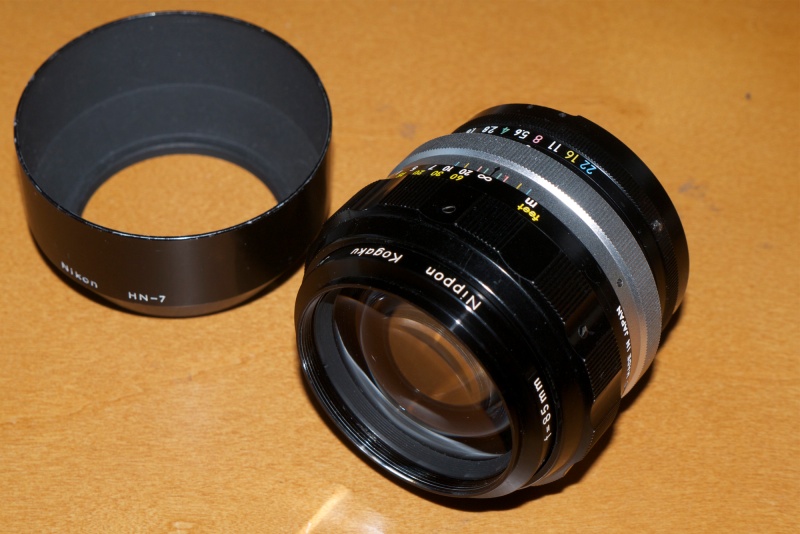
Shown with the period HN-7 screw-in hood.
If ever a lens deserves the appellation ‘famous’, it’s Nikon’s 85mm Nikkor-H f/1.8, first made in 1964. Nikon has made many f/2, f/1.8 and f/1.4 lenses of 85mm focal length since then, and while the current AF-S f/1.4 probably delivers the highest resolution of the lot, few would place the Nikkor-H far behind optically, and only non-users would argue that the current lens is better made. Much as with its contemporaries, the 20/3.5UD, 24/2.8, 28/2, 35/2, 50/1.4, 50/2, 105/2.5 and the 200/4, the construction quality, fit and finish of this lens have not been improved since.
None of the manual focus f/1.8 optics came with the Ai modification which permits mounting on later film cameras and most DSLRs. Nikon made (ugly and no longer available) Ai ‘kits’ which comprise a replacement aperture ring with the wrong surface finish, so if you want an Ai version of this lens you have three choices. Buy one which has already been converted, send it out for machining, or do it yourself. I did it myself and the task is simple. See this piece for details of how to do it yourself.
But ‘famous’? Why yes. Because this is the lens David Hemmings used in the studio scenes in Michelangelo Antonioni’s ‘Blow-Up‘ to photograph Veruschka while she writhed below him. His Nikon F with the Nikkor-H mounted can be seen in the contemporary poster.
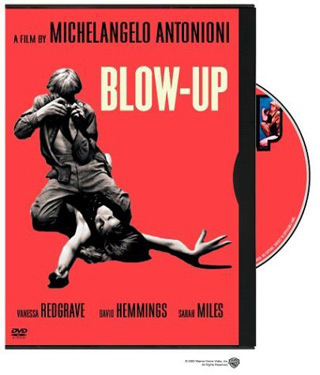
Fame.
I have long lusted after this optic but good ones go for high prices and cheap ones are usually beaten up, the anodizing on the scalloped metal focus barrel worn away and ugly. Well, I finally snapped one up in near mint condition for $210 delivered, and when it arrived the other day I immediately set to machining the aperture ring to permit mounting of the lens on my D2x and D3x Nikons. I would love to have used it on a Nikon F but no digital version of that classic was ever made, and I no longer use film.
Amazingly, the filter size is the same small 52mm common to most Nikkors of that era and the HN-7 hood screws in. No clip-on nonsense waiting to be knocked off.
Comparison with the AF-D version:
I set to making a quick test using the local back yard utility pole as my test target. My test was against the ‘plastic fantastic’ 85mm f/1.8 AF-D lens, set in the most ghastly plastic mount imaginable, but of outstanding performance. This lens is still available new in the US for $460. How Nikon manage to make a bitingly sharp optic encased in ductile materials and cheese beats me, so I confess that I ran my simple test with some trepidation. Could any lens significantly improve on the AF-D or, for that matter, even match it? My Nikkor-H is positively geriatric, having been made in February, 1969, meaning 44 years ago. It cost me $212.
I should have known better than to worry. Central definition and overall contrast of the old lens easily beat those of the newer one from f/1.8 to f/4, and vignetting is identical, disappearing by f/2.8 in the old, f/3.5 in the new. Edge resolution in the newer lens is superior through f/4 after which they are identical. In a lens of this focal length, the ideal portrait lens on full frame, central resolution is what counts.
The focus throw on this lens is very long – fully half a circle from infinity to 3 feet, making accurate focus on close subjects easy. Depth of field is very limited at wider apertures so a slow focus ring is actually an asset.
Here’s my thrilling test target, what passes as utility service in the SF Bay area, allegedly part of the most powerful nation on earth. The old MF lens is the left hand image – focal length and maximum aperture are not reported by Lightroom (in the parentheses) as I had yet to install a CPU when this was taken:
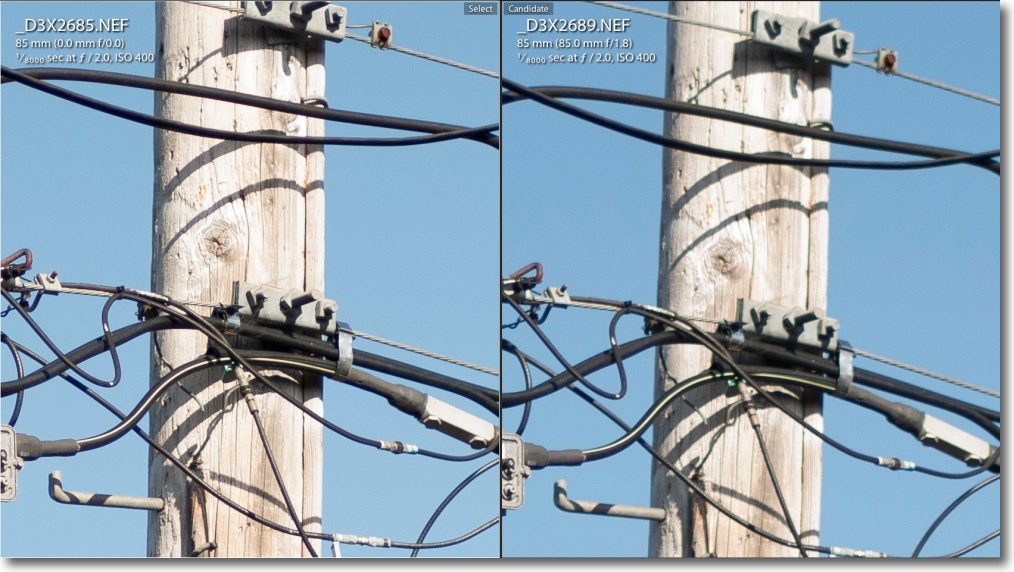
Even viewed via this blog on the 11″ display of my MacBook Air the difference is obvious at f/2, remaining so at f/1.8, f/2.8 and f/4. The enlargement above is from 5 foot 90dpi equivalent print sizes.
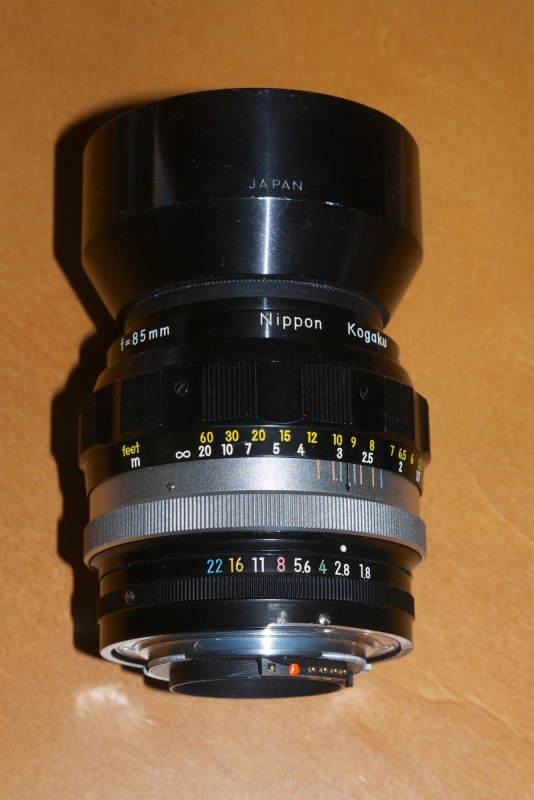
Chipped and ready to go, one of Nikon’s best ever.
The CPU confers a host of benefits, described here and installation on the 85mm f/1.8 Nikkor-H is a simple glue-on job. One key advantage is that you can pass aperture control from the control wheel on the camera’s body to the aperture ring on the lens, sidestepping the non-linearity issue I explain here. Your kit will handle better too, allowing apertures to be changed by supporting the lens properly from below with the left hand. $29 for the CPU, 5 minutes to glue it in place and another 15 minutes to program it, as described here.
Can a lens make a better photographer? When it comes with a heritage like this and when the user revels in the operational feel and the results it yields …. well, you can make your own mind up. Me? I’m going to track down Veruschka’s granddaughter.
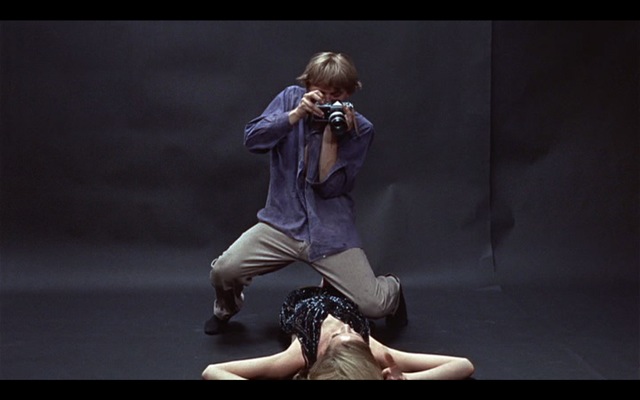
Veruschka writhes as Hemmings snaps.
Lens correction profile:
This lens is so well designed that what optical shortcomings there are – very minor vignetting down to f/3.5 – are easily corrected with my lens correction profile in LR or PS, which you can download here, but of all the pre-Ai MF Nikkors this one arguably needs a profile least. I can detect absolutely no barrel or pincushion distortion. Likewise, chromatic aberration (color fringing) is negligible, though the profile corrects what little there is. My profile was made at f/1.8, f/2.8, f/4 and f/5.6, with the last prevailing at apertures smaller than f/4. It works with both FX (Full Frame) and DX (APS-C) sensors. The profile was made on my D3x but will work on files from any Nikon DSLR.
To get a sense of what this lens can do in the studio, click here. The handling and balance on a modern full size Nikon DSLR are about as close to perfection as these things get. If you can live without AF, search one of these out.
Use on Panny MFT bodies:
A wonderful lens on the Panny G bodies with a $25 adapter, delivering 170mm f/1.8. Very shallow depth of field, and you retain aperture priority automation, the EVF never dims as you stop the lens down (think about that!) and you have a state of the art MF focusing aid which makes dead on focus trivially simple. Read more about the immense capability of the Panny MFT bodies with MF lenses here. As you are really cherry picking the center of the image circle produced by the lens, definition at any aperture all the way to the extreme edges is not an issue.
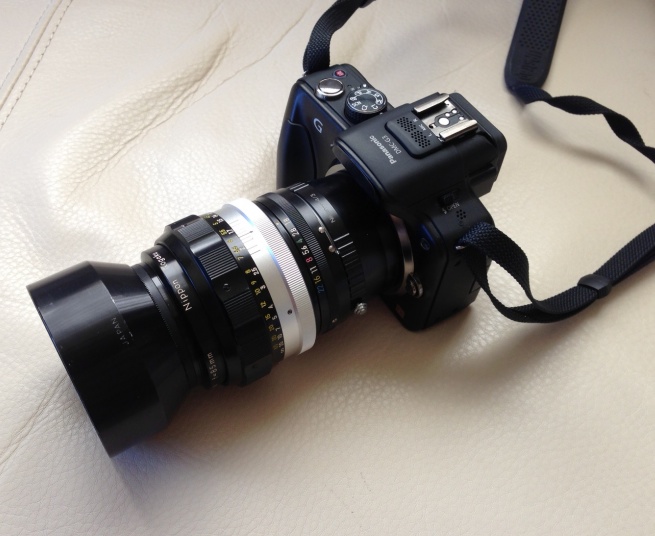
The Hemmimgs lens on the Panny G3.
A 1969 lens on a 2012 body, and fully functional. Pretty cool, huh?
Thank you for confirming that David Hemmings (aka Thomas) used the 85mm f1.8 H auto Nikkor on his Nikon F in Blowup. I had suspected it for a while. However, others have suggested that it was the 50mm f1.4 lens. Looking at pix of the Hemmings lens, I notice that there is no writing inside the lens, as there would be if it was the 50 f2 or f1.4. You will see that the 85 has the writing around the outer of the filter ring – like the 28mm f3.5/ 35mm f2 lenses to name a couple from the 1960s. I use all these lens and others on my 3 Nikon F Photomic FTN bodies (1 black) and I derive so much pleasure from the quality of build, just the feel of them. Digital? I’m not bright enough!
David – I actually ran the movie and froze the frame in the studio scene with Veruschka to confirm that it was indeed the 85/1.8. Your point about the absence of writing on the inside periphery is also correct. Hemmings uses the no less splendid 50/1.4 Nikkor-S in the scenes in Maryon Park. You can easily recognize it, and the 85 would not have fit in his Koren-model Bentley Continental‘s glove box the way he inserts it, lens up! – Ed.
Thanks for this bit you provided, so much differing unqualified opinion exist today regarding these gems that it is refreshing to read praise. The H version was primarily created to be a photojournalist/press lens specific for B&W photography use. The later HC version was to obviously enhance color. Having the HC to use for B&W is not necessarily worth the extra expense at all. We are lucky to have in Nikon a company thoughtful to share it’s historical side and to provide us this ability to understand why a particular lens was developed. The lens is truly a historical icon, from ringside to rice paddy, images captured with these lenses are our world history illustrated in the media of new era dawning. My version is as sharp as my Nikkor P.C 105mm f2.5, but the color I believe lags a bit (which is probably true for about 99% of all other lenses as well). This H version is just a stellar B&W performer anyone should have just for that purpose or intent only.